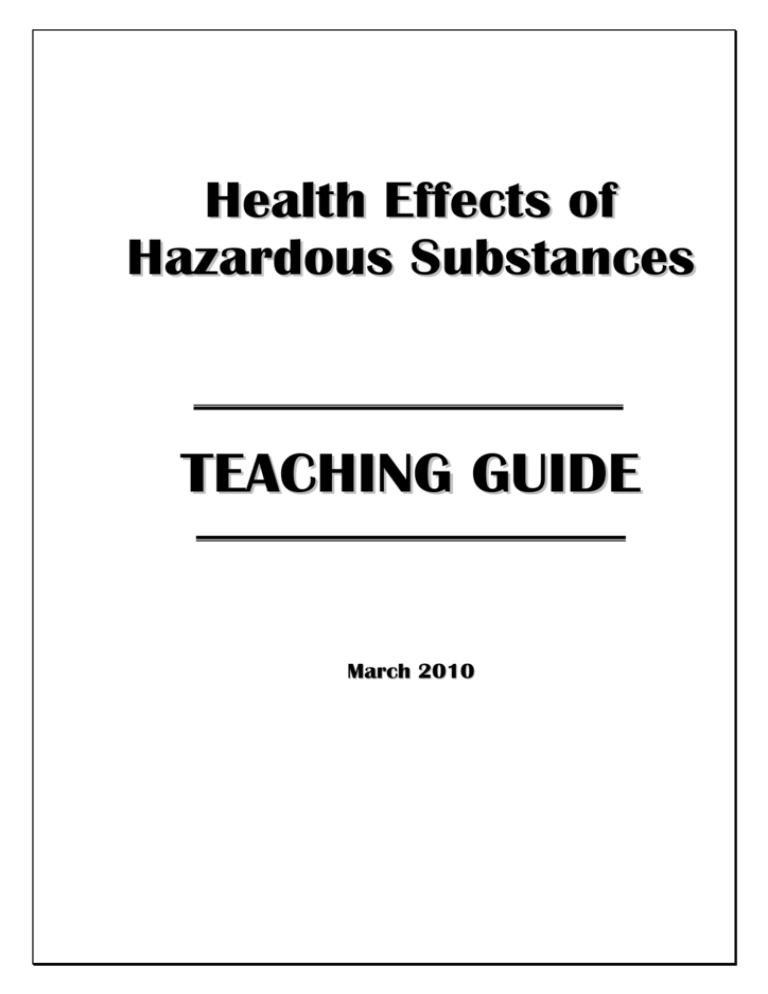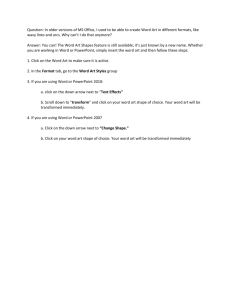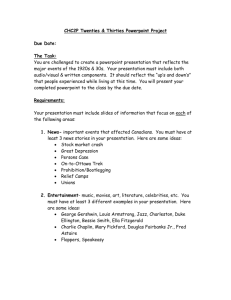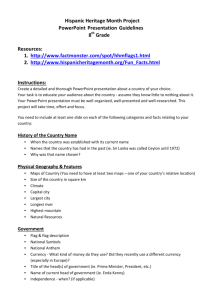Teaching Guide
advertisement

Health Effects of Hazardous Substances TEACHING GUIDE March 2010 TEACHING GUIDE – DAY 1 BASIC PRINCIPLES OF TOXICOLOGY - STUDENT LEARNING OUTCOMES: 1. Able to provide definitions of commonly used toxicological terms. 2. Understand that exposure to more than one hazardous substance at the same may alter the extent of the health effect. 3. Able to identify the main limitations of toxicity testing data. TYPES OF HEALTH EFFECTS - STUDENT LEARNING OUTCOMES: 4. Aware of the main types of health effects that may occur from exposure to hazardous substances BASIC HUMAN BIOLOGY AND TARGET ORGANS - STUDENT LEARNING OUTCOMES: 5. Able to describe the main features of the principle target organs affected by exposure to hazardous substances at work 6. Able to describe the main health effects that can occur at the target organs and give examples of substances that can cause these effects 2. Time 0-30 minutes 30-60 minutes Topic Course Opening Course Overview Course Overview (Cont’d) Contents Learning Processes Learning Resources Welcome Welcome participants to course Emergency Procedures Indicate the Site Emergency Procedures to participants PowerPoint Introductions Introduce the lecturers and ask participants to introduce themselves and indicate their background in occupational hygiene PowerPoint Course Aims Indicate the course aims PowerPoint Overall Learning Outcomes Indicate the overall course learning outcomes PowerPoint Topics to be Covered Discuss the topics to be covered in the course PowerPoint Format of course Explain overall format of course PowerPoint Today’s Learning Outcomes Indicate the learning outcomes for Day 1 Assessment & Learning Outcomes Understanding of Emergency Procedures 3. Time 60-120 minutes Topic Introduction to Toxicology Contents Coffee Break Learning Resources Assessment & Learning Outcomes Assignment of Groups Assign individuals to a work group. Ensure persons with some experience are distributed evenly amongst groups Introduction and basic toxicological terms Discussion of information with other examples being added by students where possible PowerPoint Learning Outcome 1 Types of combined effects Discuss types of combined effects PowerPoint Learning Outcome 2 Limitations of toxicity testing Seek students ideas on limitations before showing slide PowerPoint Learning Outcome 3 Nitroglycerin case study 120-150 minutes Learning Processes PowerPoint and description of process 4. Time Topic Contents Learning Processes Learning Resources 150-180 minutes Types of Health Effects Definitions Describe main types of health effects with extra examples added by tutor and students PowerPoint 180-240 minutes Types of Health Effects Group work Students split into work groups to generate lists of hazardous substances and types of health effects. Groups to report back to whole class 240-300 minutes Lunch Break 300-360 minutes Basic human biology and target organs Respiratory system and skin Describe the structure of the target organs. Illustrate health effects with examples of substances that cause the effects PowerPoint 360-390 minutes Polyurethane manufacture case study Students split into work groups to discuss work procedures and processes. Groups to report back to whole class on controls in place and exposure routes PowerPoint and description of process Assessment & Learning Outcomes Learning Outcome 4 Reinforce Learning Outcome 4 Learning Outcome 5 and 6 5. Time Topic Contents Learning Processes 390-420 minutes Coffee Break 420-480 minutes Basic human biology and target organs Nervous system, circulatory system, liver, kidney and reproductive system Describe the structure of the target organs. Illustrate health effects with examples of substances that cause the effects 480-510 minutes Learning Outcomes Review of today’s Learning Outcomes Review and discuss Learning Resources PowerPoint Assessment & Learning Outcomes Learning Outcome 5 and 6 Agreement that learning outcomes for today have been achieved TEACHING GUIDE – DAY 2 REVIEW OF OVERNIGHT QUESTIONS - STUDENT LEARNING OUTCOMES: 1. Receive guidance in understanding the reasons for any incorrect answers to the overnight questions from Day 1. BASIC TOXICOKINETICS - STUDENT LEARNING OUTCOMES: 2. Able to describe the main routes by which hazardous substances can enter the body. 3. Understand the factors which influence the absorption, distribution, storage and elimination of hazardous substances. DOSE RESPONSE AND TOXICITY TESTING - STUDENT LEARNING OUTCOMES: 4. Can provide definitions of commonly used toxicity testing terms. 5. Describe the main features of dose response curves. 6. Be familiar with a range of toxicity testing techniques and their applications. EPIDEMIOLOGY - STUDENT LEARNING OUTCOMES: 7. Aware of the main types of epidemiological studies and their applications and limitations. 8. Can undertake basic interpretation of the results of epidemiological studies. 2. Time 0-30 minutes Topic Contents Learning Processes Learning Outcomes Learning outcomes for today Indicate the learning outcomes for Day 2 Overnight Questions Student Guidance Discuss answers to questions and provide guidance where required Learning Resources Answer sheet Assessment & Learning Outcomes Satisfactory understanding and successful completion of questions Learning Outcome 1 30-90 minutes Basic toxicokinetics 90-120 minutes 120–150 minutes Coffee Break 150-180 minutes Dose response and toxicity testing Toxicokinetics Describe the four stages of toxicokinetics. Highlight the possibility that metabolism may increase or decrease the potential hazard of a substance PowerPoint Learning Outcome 2 and 3 Half-life Describe the concept of half-life. Discuss the implications of different half lives and shift patterns by reference to examples from the students experience where possible PowerPoint Reinforce Learning Outcome 3 Dose response curves Describe dose response curves and their main features. PowerPoint Learning Outcomes 4 and 5 3. Time Topic 180-240 minutes Contents Learning Processes Learning Resources Assessment & Learning Outcomes Dose response syndicate work Using the materials provided, students break into groups and complete the required tasks Dose response data and graphs Reinforce learning outcomes 4 and 5 240-30 minutes Lunch Break 300-330 minutes Dose response and toxicity testing Toxicity testing Describe the main types of toxicity testing techniques and their applications PowerPoint Learning outcome 6 330-390 minutes Epidemiology Epidemiological terms, Bradford Hill criteria and types of studies. Explain epidemiological terms including causation and association. Introduce Bradford Hill criteria and how they are applied. Discuss types of study and their application, using examples where possible from student’s experience. PowerPoint Learning outcome 7 390-420 minutes Coffee Break 420-510 minutes Epidemiology Case study Using the materials provided, students break into groups and complete the required tasks PowerPoint and additional Learning Outcome 8 information sheets 4. Time Topic Learning Outcomes Contents Review of Learning Outcomes Learning Processes Discuss what topics have been covered today Learning Resources Assessment & Learning Outcomes Agreement that learning outcomes have been achieved TEACHING GUIDE – DAY 3 REVIEW OF OVERNIGHT QUESTIONS - STUDENT LEARNING OUTCOMES: 1. Receive guidance in understanding the reasons for any incorrect answers to the overnight questions from Day 2. REGULATORY CONSIDERATIONS - STUDENT LEARNING OUTCOMES: 2. Describe the main sources of information on hazardous substances and processes. 3. Understand the importance of critically evaluating information sources when deciding on risks and control strategies. OVERVIEW OF HEALTH EFFECTS - STUDENT LEARNING OUTCOMES: 4. Be aware of the likely health effects of a range of commonly encountered hazardous substances and typical sources of exposure. 2. Time 0-30 minutes Topic Contents Learning Processes Learning Outcomes Learning outcomes for today Indicate the learning outcomes for Day 3 Overnight Questions Student Guidance Discuss answers to questions and provide guidance where required Learning Resources Answer sheet Assessment & Learning Outcomes Satisfactory understanding and successful completion of questions Learning Outcome 1 30-60 minutes Regulatory considerations 60-120 minutes 120-150 minutes Coffee Break 150-180 minutes Regulatory considerations 180-210 minutes Introduction Discuss risk and safety phrases and use of data sheets PowerPoint Group work – data sheets Using the materials provided, students break into groups and complete the required tasks PowerPoint and data sheets Discussion on data sheets and description of other data sources Groups to report back on what they would ideally be provided with on data sheets Results of group work and Learning Outcome 2 PowerPoint Laser printer case study Discuss issues raised in PowerPoint and additional Learning outcome 3 case study by whole group information sheets discussion and participation Learning Outcome 2 3. Time Topic 210-240 minutes 240-300 minutes Lunch Break 300-390 minutes Overview of health effects 390-420 minutes Coffee break 420-450 minutes Overview of health effects continued Contents Learning Processes Learning Resources SAICM and REACH Describe SAICM and REACH and discuss how these approaches may improve quality of information on data sheets and risk assessments Gases, organic solvents and liquids, metals, crystalline silica Describe the likely health PowerPoint effects of the hazardous substances and typical sources of exposure. Where possible involve the students by using examples from their experience. Other dusts and particulate materials, mineral fibres Describe the likely health PowerPoint effects of the hazardous substances and typical sources of exposure. Where possible involve the students by using examples from their experience. Assessment & Learning Outcomes PowerPoint Learning outcome 4 4. Time Topic 450-510 minutes Learning Outcomes Contents Learning Processes Case study – Paint manufacture Describe paint manufacturing processes shown and allow students to watch video clips several times. Students break into groups and complete the required tasks Review of Learning Outcomes Discuss what topics have been covered today Learning Resources PowerPoint and video, data sheets previously examined in groups Assessment & Learning Outcomes Reinforce learning outcome 4 Agreement that learning outcomes have been achieved TEACHING GUIDE – DAY 4 REVISION OF OVERNIGHT QUESTIONS - STUDENT LEARNING OUTCOMES: 1. Receive guidance in understanding the reasons for any incorrect answers to the overnight questions from Day 3. COMMON INDUSTRIAL PROCESSES - STUDENT LEARNING OUTCOMES: 2. Be aware of the main hazardous substances that are likely to be encountered in a range of common industrial processes. Understand how exposures are likely to occur and what controls would typically be in place. SPECIFIC INDUSTRY PROFILES - STUDENT LEARNING OUTCOMES: 3. Be aware of the main hazardous substances that are likely to be encountered in a range of specific industries. Understand how exposures are likely to occur and what controls would typically be in place. 2. Time 0-30 minutes Topic Contents Learning Processes Learning Outcomes Learning outcomes for today Indicate the learning outcomes for Day 4 Overnight Questions Student Guidance Discuss answers to questions and provide guidance where required Learning Resources Answer sheet Assessment & Learning Outcomes Satisfactory understanding and successful completion of questions Learning Outcome 1 30-120 minutes Common Industrial Processes 120-150 minutes Coffee break 150-240 minutes All processes in section Describe the common PowerPoint industrial processes and identify the main hazardous substances that are likely to be encountered. Illustrate with examples how exposures are likely to occur and what controls would typically be in place. Learning outcome 2 Group work – health effects Describe building demolition scenario and explain the task of identifying likely hazardous substances likely to be encountered during the proposed works. Reinforce learning outcome 2 Students break into groups and complete the required tasks PowerPoint 3. Time Topic Contents Learning Processes 240-300 minutes Lunch Break 300-390 minutes Specific industry profiles 390-420 minutes Coffee break 420-480 minutes Specific industry profiles Case study – Pharmaceutical Describe pharmaceutical production and packing production and packing process and allow students to watch video clips several times. Students break into groups and complete the required tasks 480-510 minutes Learning Outcomes Review of Learning Outcomes All industries in section Learning Resources Describe the specific PowerPoint industrial processes and identify the main hazardous substances that are likely to be encountered. Illustrate with examples how exposures are likely to occur and what controls would typically be in place. Discuss what topics have been covered today PowerPoint and video Assessment & Learning Outcomes Learning outcome 3 Reinforce learning outcome 4 Agreement that learning outcomes have been achieved TEACHING GUIDE – DAY 5 REVISION OF OVERNIGHT QUESTIONS - STUDENT LEARNING OUTCOMES: 1. Receive guidance in understanding the reasons for any incorrect answers to the overnight questions from Day 4. FACILITATED DISCUSSION ON EXPOSURE LIMIT SETTING - STUDENT LEARNING OUTCOMES: 2. Be aware of the issues that need to be considered when deciding on an exposure limit EXAMINATION 2. Time 0-30 minutes Topic Learning Processes Contents Learning Outcomes Today’s learning outcomes Review Overnight Questions Student Guidance Discuss answers to questions and provide guidance where required Learning Resources Answer sheet Assessment & Learning Outcomes Satisfactory understanding and successful completion of questions Learning Outcome 1 30–120 minutes Setting an exposure limit for a hazardous substance 120-150 minutes Coffee Break 150-210 minutes Final review 210-270 minutes Lunch Break 270-370 minutes Final exam Areas to be identified and discussed to include: Type of health effect, selection of critical health endpoint(s), routes of exposure, toxicity testing, epidemiology, research articles, chemical analogy, threshold / non-threshold, uncertainty factors, sampling methodology, acceptable risk Any questions or issues? Facilitated group discussion to explore in a qualitative manner the issues that need to be taken into account when setting an occupational exposure limit Discussion Apply and reinforce learning outcomes from the course







